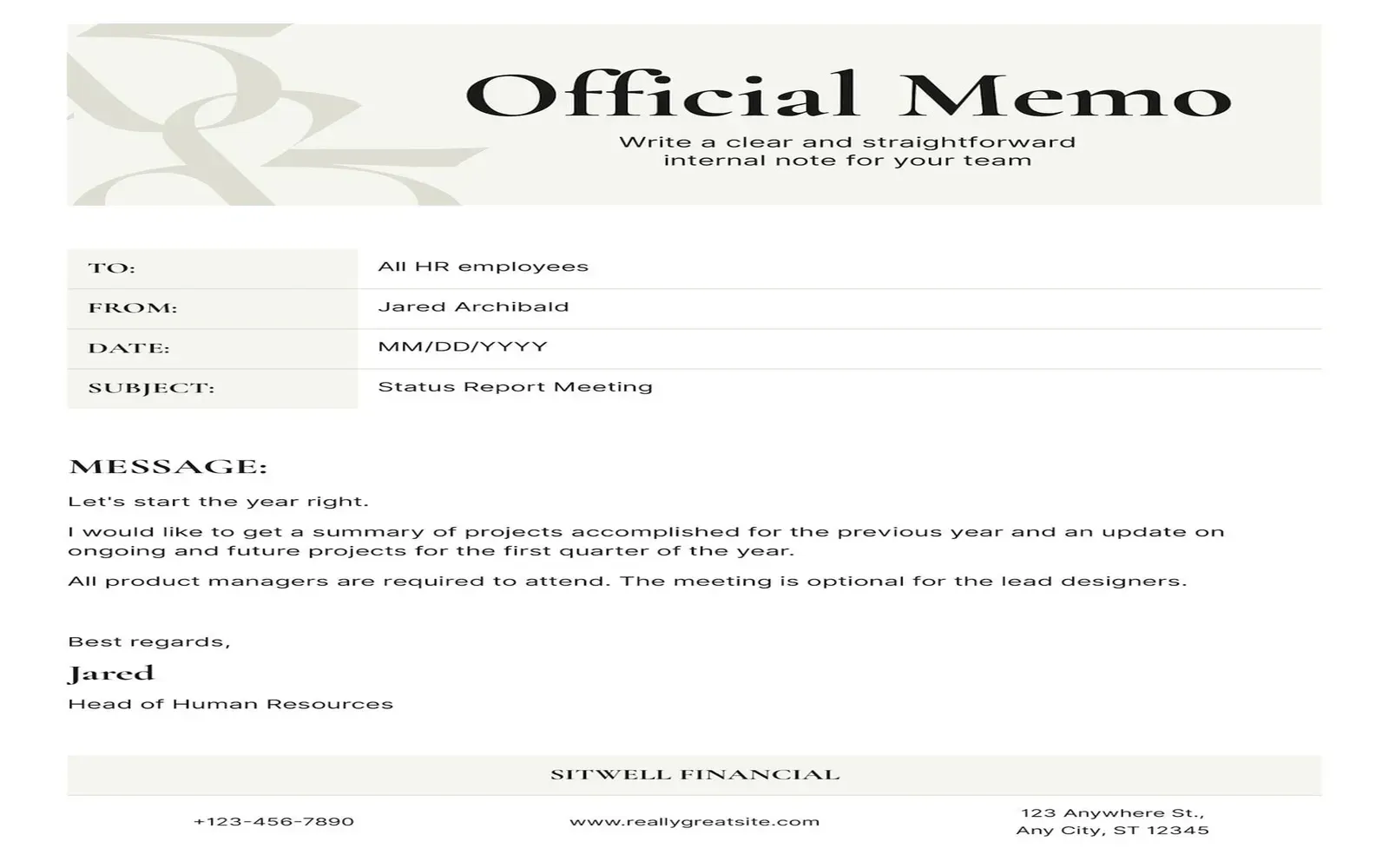Understanding the Basics of a Memo
A memo, short for memorandum, is a concise document used for communication within an organization. Its primary purpose is to inform or remind employees about important information, policies, or decisions. To write an effective memo, it is crucial to understand its structure and key components. Generally, a memo should include a header, an introduction, a body, and a conclusion. Each section plays a vital role in ensuring clarity and effectiveness.
Key Components of a Memo
When crafting a memo, consider the following key components:
- Header: This includes the "To," "From," "Date," and "Subject" lines.
- Introduction: Provide a brief overview of the memo’s purpose.
- Body: This is where you present the main information, arguments, or details.
- Conclusion: Summarize the key points and include any action items or recommendations.
Memo Format
The format of a memo is straightforward. Here’s a simple structure you can follow:
| Section | Content |
|---|---|
| To: | Recipient's name and title |
| From: | Your name and title |
| Date: | The date of the memo |
| Subject: | Brief summary of the memo's topic |
| Introduction: | State the purpose of the memo |
| Body: | Details, arguments, or information |
| Conclusion: | Summary and action items |
Common Memo Templates
Using a template can simplify the memo-writing process. Here are a few common templates based on different scenarios:
General Memo Template
To: [Recipient's Name]
From: [Your Name]
Date: [Today's Date]
Subject: [Memo Subject]
Dear [Recipient's Name],
[Introduction: Briefly explain the purpose of the memo.]
[Body: Elaborate on the key points, using bullet points for clarity if necessary.]
[Conclusion: Summarize the main points and specify any required actions.]
Best regards,
[Your Name]
Meeting Memo Template
To: [Recipient's Name]
From: [Your Name]
Date: [Today's Date]
Subject: Meeting on [Date]
Dear Team,
This memo is to inform you about a meeting scheduled for [Date] at [Time].
[Body: Include agenda items, expected outcomes, and any preparation required.]
Thank you,
[Your Name]
Informational Memo Template
To: [Recipient's Name]
From: [Your Name]
Date: [Today's Date]
Subject: Important Update on [Topic]
Dear [Recipient's Name],
I am writing to inform you about [brief overview of the update].
[Body: Provide detailed information, statistics, or findings related to the topic.]
[Conclusion: Discuss the implications of this information and any next steps.]
Regards,
[Your Name]
Examples of Effective Memos
Here are a couple of examples that illustrate how to communicate effectively through memos:
Example 1: Policy Change Memo
To: All Employees
From: HR Department
Date: [Insert Date]
Subject: Changes to Remote Work Policy
Dear Team,
This memo serves to inform you of changes to our remote work policy, effective [Date].
The key changes are:
- Employees are now eligible to work remotely up to three days per week.
- Requests for remote work must be submitted to your supervisor for approval.
- Regular check-ins will be scheduled to ensure team collaboration.
We encourage you to reach out with any questions.
Thank you,
HR Department
Example 2: Project Update Memo
To: Project Team
From: [Your Name]
Date: [Insert Date]
Subject: Project X Status Update
Dear Team,
I wanted to provide you with an update regarding Project X.
As of today:
- We have completed the initial phase on schedule.
- The next phase is set to commence on [Date].
- Please ensure that any outstanding tasks are completed by the end of the week.
Thank you for your hard work!
[Your Name]
Final Tips for Writing Memorable Memos
To ensure your memo is effective, keep these tips in mind:
- Be clear and concise.
- Use bullet points for easy reading.
- Maintain a professional tone.
- Proofread for grammar and clarity.
By following these guidelines and utilizing the templates and examples provided, you can write effective memos that communicate your message clearly and efficiently within your organization.





